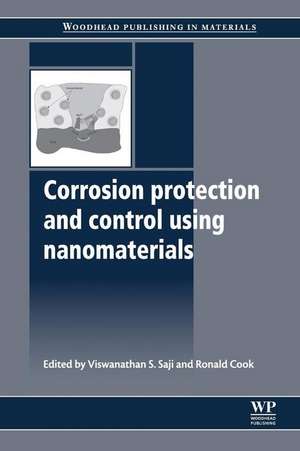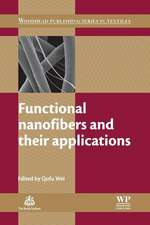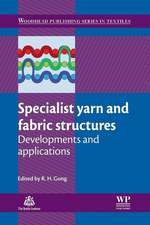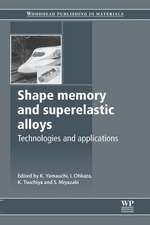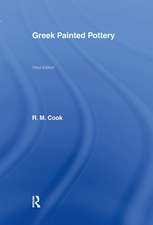Corrosion Protection and Control Using Nanomaterials: Woodhead Publishing Series in Metals and Surface Engineering
Editat de V S Saji, R. M. Cooken Limba Engleză Paperback – 18 aug 2016
The book is divided into two parts. Part one looks at the fundamentals of corrosion behaviour and the manufacture of nanocrystalline materials. Chapters discuss the impact of nanotechnology in reducing corrosion cost, and investigate the influence of various factors including thermodynamics, kinetics and grain size on the corrosion behaviour of nanocrystalline materials. There are also chapters on electrodeposition and the corrosion behaviour of electrodeposited nanocrystalline materials. Part two provides a series of case studies of applications of nanomaterials in corrosion control. Chapters review oxidation protection using nanocrystalline structures at various temperatures, sol- gel and self-healing nanocoatings and the use of nanoreservoirs and polymer nanocomposites in corrosion control.
With its distinguished editors and international team of expert contributors, Corrosion protection and control using nanomaterials is an invaluable reference tool for researchers and engineers working with nanomaterials in a variety of industries including, aerospace, automotive and chemical engineering as well as academics studying the unique protection and control offered by nanomaterials against corrosion.
- Explores the potential use of nanotechnology and nanomaterials for corrosion prevention, protection and control
- Discusses the impact of nanotechnology in reducing corrosion cost and investigates various factors on the corrosion behaviour of nanocrystalline materials
- Provides a series of case studies and applications of nanomaterials for corrosion control
Din seria Woodhead Publishing Series in Metals and Surface Engineering
- 24%
 Preț: 898.37 lei
Preț: 898.37 lei - 9%
 Preț: 1028.21 lei
Preț: 1028.21 lei - 24%
 Preț: 1044.05 lei
Preț: 1044.05 lei - 24%
 Preț: 1339.97 lei
Preț: 1339.97 lei - 23%
 Preț: 1227.85 lei
Preț: 1227.85 lei - 9%
 Preț: 1136.94 lei
Preț: 1136.94 lei - 24%
 Preț: 1165.93 lei
Preț: 1165.93 lei - 9%
 Preț: 812.20 lei
Preț: 812.20 lei - 9%
 Preț: 960.56 lei
Preț: 960.56 lei - 9%
 Preț: 1396.45 lei
Preț: 1396.45 lei - 9%
 Preț: 810.22 lei
Preț: 810.22 lei - 9%
 Preț: 1140.04 lei
Preț: 1140.04 lei - 29%
 Preț: 1334.26 lei
Preț: 1334.26 lei - 24%
 Preț: 1130.31 lei
Preț: 1130.31 lei - 23%
 Preț: 864.86 lei
Preț: 864.86 lei - 9%
 Preț: 1135.38 lei
Preț: 1135.38 lei - 27%
 Preț: 1999.27 lei
Preț: 1999.27 lei - 24%
 Preț: 1561.85 lei
Preț: 1561.85 lei - 24%
 Preț: 1624.39 lei
Preț: 1624.39 lei - 27%
 Preț: 1370.57 lei
Preț: 1370.57 lei - 24%
 Preț: 933.30 lei
Preț: 933.30 lei - 24%
 Preț: 1131.24 lei
Preț: 1131.24 lei - 9%
 Preț: 1158.68 lei
Preț: 1158.68 lei
Preț: 1083.66 lei
Preț vechi: 1190.84 lei
-9% Nou
Puncte Express: 1625
Preț estimativ în valută:
207.39€ • 215.71$ • 171.21£
207.39€ • 215.71$ • 171.21£
Carte tipărită la comandă
Livrare economică 07-21 aprilie
Preluare comenzi: 021 569.72.76
Specificații
ISBN-13: 9780081016619
ISBN-10: 0081016611
Pagini: 424
Dimensiuni: 156 x 234 x 25 mm
Greutate: 0.59 kg
Editura: ELSEVIER SCIENCE
Seria Woodhead Publishing Series in Metals and Surface Engineering
ISBN-10: 0081016611
Pagini: 424
Dimensiuni: 156 x 234 x 25 mm
Greutate: 0.59 kg
Editura: ELSEVIER SCIENCE
Seria Woodhead Publishing Series in Metals and Surface Engineering
Cuprins
Contributor contact details
Preface
Part I: Corrosion behaviour and manufacture of nanocrystalline materials
Chapter 1: The impact of nanotechnology on reducing corrosion cost
Abstract:
1.1 Introduction
1.2 Nanotechnology and corrosion
1.3 Corrosion/oxidation behavior of nanostructured materials
1.4 Nanomaterials in corrosion prevention
1.5 Conclusions
Chapter 2: Corrosion and nanomaterials: thermodynamic and kinetic factors
Abstract:
2.1 Introduction
2.2 Corrosion
2.3 Thermodynamics
2.4 Kinetics
2.5 Applications
2.6 Conclusions
Chapter 3: Understanding the corrosion resistance of nanocrystalline materials: the influence of grain size
Abstract:
3.1 Introduction
3.2 Grain boundary and electron movement: the corrosion mechanism of nanocrystalline metals
3.3 Theory of interaction between the grain boundary of nanocrystalline metals and electron movement
3.4 Lattice distortion, Fermi energy and Fermi velocity of nanocrystalline metals
3.5 Influence of reduction in grain size
3.6 Conclusions
Chapter 4: Understanding the corrosion resistance of nanocrystalline materials: electrochemical influences
Abstract:
4.1 Introduction
4.2 Active dissolution of nanocrystalline materials in a liquid system
4.3 Passivation ability of nanocrystalline materials
4.4 Pitting corrosion of nanocrystalline metals
4.5 Effect of grain size on electrochemical corrosion behaviors
4.6 Conclusions
Chapter 5: Electrodeposition: the versatile technique for nanomaterials
Abstract:
5.1 Introduction
5.2 Nanomaterials applied by electrodeposition
5.3 Special techniques for grain size reduction
5.4 Electrodeposited nanomaterials
5.5 Corrosion resistance of electrodeposited nanomaterials
5.6 Conclusions
5.7 Acknowledgments
Part II: The use of nanomaterials in corrosion control
Chapter 6: Moderate temperature oxidation protection using nanocrystalline structures
Abstract:
6.1 Introduction
6.2 Structure and properties of nanocrystalline metals
6.3 Thermal stability and synthesis of nanocrystalline metals and alloys
6.4 Degradation of nanocrystalline metals and alloys by environment
6.5 Oxidation resistance of nanocrystalline metals/alloys
6.6 Conclusions
6.7 Acknowledgements
Chapter 7: High temperature oxidation protection using nanocrystalline coatings
Abstract:
7.1 Introduction
7.2 High temperature oxidation resistant metallic coatings
7.3 Ceramic coatings for high temperature oxidation protection
7.4 Conclusions
7.5 Acknowledgements
Chapter 8: Nanocoatings to improve the tribocorrosion performance of materials
Abstract:
8.1 Introduction
8.2 The role of nanoparticles in tribocorrosion
8.3 Tribocorrosion resistance and nanocrystalline coatings
8.4 Conclusions
8.5 Acknowledgments
Chapter 9: Self-healing nanocoatings for corrosion control
Abstract:
9.1 Introduction
9.2 Concept of ‘self-healing’
9.3 Polymer bulk composites and coatings
9.4 Traditional conversion coatings
9.5 Sol–gel silane coatings
9.6 Sol–gel coatings with nanoreservoirs
9.7 Conductive polymer coatings
9.8 Conclusions
Chapter 10: The use of nanoreservoirs in corrosion protection coatings
Abstract:
10.1 Introduction
10.2 Nanocontainers in coatings
10.3 Conclusions
Chapter 11: Nanoparticle-based corrosion inhibitors and self-assembled monolayers
Abstract:
11.1 Introduction
11.2 Surface-modified nanoparticles as corrosion inhibitors
11.3 Cerium-activated nanoparticles as corrosion inhibitors
11.4 Functionalized nanoparticles and nanostructures as carriers
11.5 Nanoparticle-based biocides
11.6 Self-assembled nanofilms as corrosion inhibitors
11.7 Conclusions
Chapter 12: Sol–gel nanocoatings for corrosion protection
Abstract:
12.1 Introduction
12.2 Nanotechnology in coatings
12.3 Sol–gel coatings: historical perspective and chemistry
12.4 Critical features of sol–gel coatings for corrosion protection
12.5 Corrosion-resistant sol–gel coatings
12.6 Organosilane and conventional organic polymer derived sol–gel coatings
12.7 Industrial applications of sol–gel coatings
12.8 Conclusions
12.9 Acknowledgement
Chapter 13: Polymer nanocomposites in corrosion control
Abstract:
13.1 Introduction
13.2 Structure of clay
13.3 Polymer/clay nanocomposite (PCN) structures
13.4 Methods for synthesizing PCN
13.5 Anticorrosive properties
13.6 Conclusions
Chapter 14: Nanocoatings for corrosion protection of aerospace alloys
Abstract:
14.1 Introduction
14.2 Nanotechnology-associated approaches
14.3 Conclusions
14.4 Acknowledgment
Chapter 15: Nanoscience and biomaterial corrosion control
Abstract:
15.1 Introduction
15.2 General and localized corrosion in orthopaedics and dental implants
15.3 Nanostructured biomaterials
15.4 Nanoscale surface modifications and corrosion resistance
15.5 Nanostructured ceramic coatings
15.6 Resorbable biomaterials: nanoscale approaches
15.7 Conclusions
Index
Preface
Part I: Corrosion behaviour and manufacture of nanocrystalline materials
Chapter 1: The impact of nanotechnology on reducing corrosion cost
Abstract:
1.1 Introduction
1.2 Nanotechnology and corrosion
1.3 Corrosion/oxidation behavior of nanostructured materials
1.4 Nanomaterials in corrosion prevention
1.5 Conclusions
Chapter 2: Corrosion and nanomaterials: thermodynamic and kinetic factors
Abstract:
2.1 Introduction
2.2 Corrosion
2.3 Thermodynamics
2.4 Kinetics
2.5 Applications
2.6 Conclusions
Chapter 3: Understanding the corrosion resistance of nanocrystalline materials: the influence of grain size
Abstract:
3.1 Introduction
3.2 Grain boundary and electron movement: the corrosion mechanism of nanocrystalline metals
3.3 Theory of interaction between the grain boundary of nanocrystalline metals and electron movement
3.4 Lattice distortion, Fermi energy and Fermi velocity of nanocrystalline metals
3.5 Influence of reduction in grain size
3.6 Conclusions
Chapter 4: Understanding the corrosion resistance of nanocrystalline materials: electrochemical influences
Abstract:
4.1 Introduction
4.2 Active dissolution of nanocrystalline materials in a liquid system
4.3 Passivation ability of nanocrystalline materials
4.4 Pitting corrosion of nanocrystalline metals
4.5 Effect of grain size on electrochemical corrosion behaviors
4.6 Conclusions
Chapter 5: Electrodeposition: the versatile technique for nanomaterials
Abstract:
5.1 Introduction
5.2 Nanomaterials applied by electrodeposition
5.3 Special techniques for grain size reduction
5.4 Electrodeposited nanomaterials
5.5 Corrosion resistance of electrodeposited nanomaterials
5.6 Conclusions
5.7 Acknowledgments
Part II: The use of nanomaterials in corrosion control
Chapter 6: Moderate temperature oxidation protection using nanocrystalline structures
Abstract:
6.1 Introduction
6.2 Structure and properties of nanocrystalline metals
6.3 Thermal stability and synthesis of nanocrystalline metals and alloys
6.4 Degradation of nanocrystalline metals and alloys by environment
6.5 Oxidation resistance of nanocrystalline metals/alloys
6.6 Conclusions
6.7 Acknowledgements
Chapter 7: High temperature oxidation protection using nanocrystalline coatings
Abstract:
7.1 Introduction
7.2 High temperature oxidation resistant metallic coatings
7.3 Ceramic coatings for high temperature oxidation protection
7.4 Conclusions
7.5 Acknowledgements
Chapter 8: Nanocoatings to improve the tribocorrosion performance of materials
Abstract:
8.1 Introduction
8.2 The role of nanoparticles in tribocorrosion
8.3 Tribocorrosion resistance and nanocrystalline coatings
8.4 Conclusions
8.5 Acknowledgments
Chapter 9: Self-healing nanocoatings for corrosion control
Abstract:
9.1 Introduction
9.2 Concept of ‘self-healing’
9.3 Polymer bulk composites and coatings
9.4 Traditional conversion coatings
9.5 Sol–gel silane coatings
9.6 Sol–gel coatings with nanoreservoirs
9.7 Conductive polymer coatings
9.8 Conclusions
Chapter 10: The use of nanoreservoirs in corrosion protection coatings
Abstract:
10.1 Introduction
10.2 Nanocontainers in coatings
10.3 Conclusions
Chapter 11: Nanoparticle-based corrosion inhibitors and self-assembled monolayers
Abstract:
11.1 Introduction
11.2 Surface-modified nanoparticles as corrosion inhibitors
11.3 Cerium-activated nanoparticles as corrosion inhibitors
11.4 Functionalized nanoparticles and nanostructures as carriers
11.5 Nanoparticle-based biocides
11.6 Self-assembled nanofilms as corrosion inhibitors
11.7 Conclusions
Chapter 12: Sol–gel nanocoatings for corrosion protection
Abstract:
12.1 Introduction
12.2 Nanotechnology in coatings
12.3 Sol–gel coatings: historical perspective and chemistry
12.4 Critical features of sol–gel coatings for corrosion protection
12.5 Corrosion-resistant sol–gel coatings
12.6 Organosilane and conventional organic polymer derived sol–gel coatings
12.7 Industrial applications of sol–gel coatings
12.8 Conclusions
12.9 Acknowledgement
Chapter 13: Polymer nanocomposites in corrosion control
Abstract:
13.1 Introduction
13.2 Structure of clay
13.3 Polymer/clay nanocomposite (PCN) structures
13.4 Methods for synthesizing PCN
13.5 Anticorrosive properties
13.6 Conclusions
Chapter 14: Nanocoatings for corrosion protection of aerospace alloys
Abstract:
14.1 Introduction
14.2 Nanotechnology-associated approaches
14.3 Conclusions
14.4 Acknowledgment
Chapter 15: Nanoscience and biomaterial corrosion control
Abstract:
15.1 Introduction
15.2 General and localized corrosion in orthopaedics and dental implants
15.3 Nanostructured biomaterials
15.4 Nanoscale surface modifications and corrosion resistance
15.5 Nanostructured ceramic coatings
15.6 Resorbable biomaterials: nanoscale approaches
15.7 Conclusions
Index
